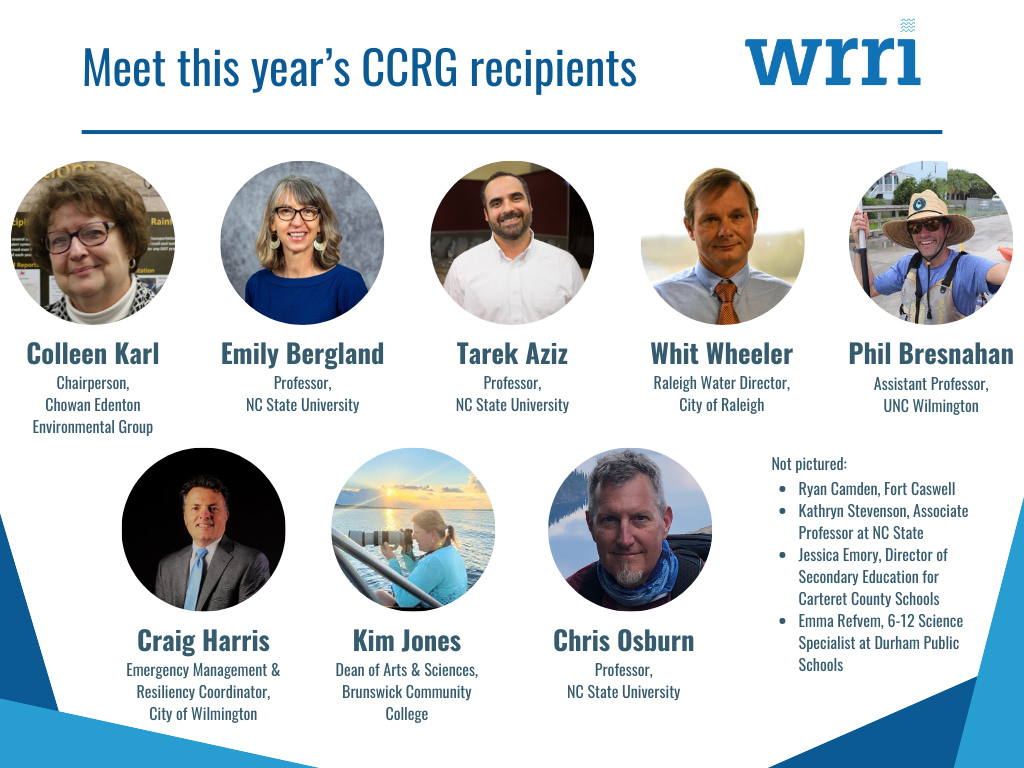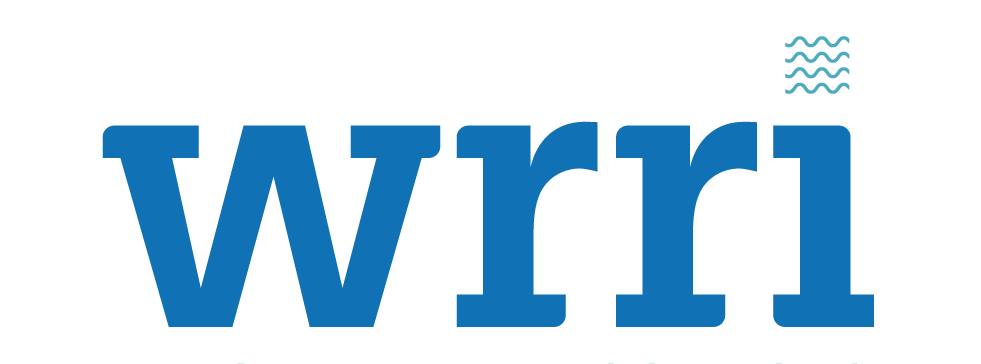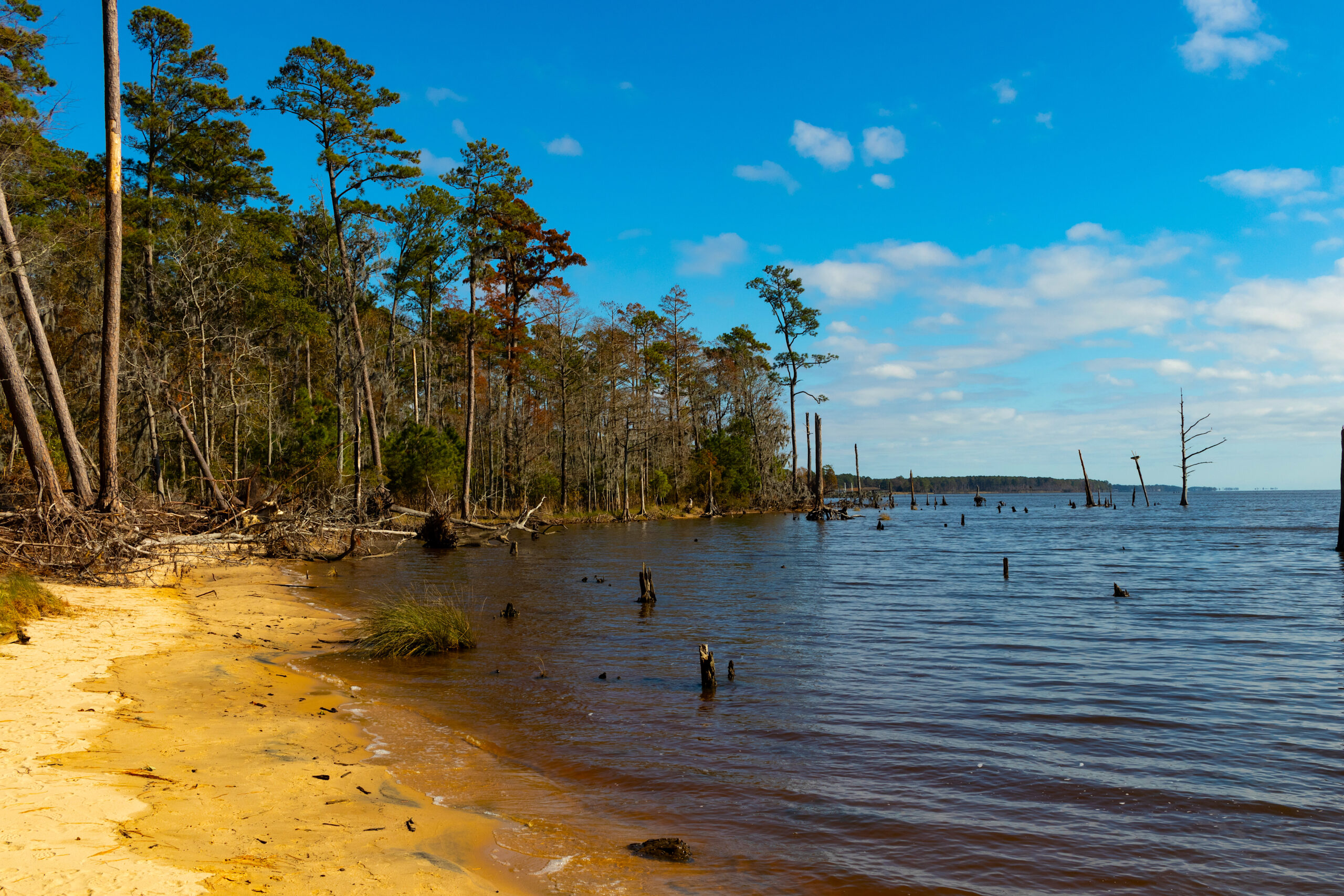Announcing Our 2024 CCRG Grant Recipients

Five new projects have received funding from the Community Collaborative Research Grant Program (CCRG). North Carolina Sea Grant and N.C. Water Resources Research Institute (WRRI) administer the CCRG Program in partnership with the William R. Kenan Jr. Institute for Engineering, Technology and Science (KIETS).
These projects, which couple scientific expertise with local knowledge, foster collaboration between researchers and community members. This year’s CCRG recipients are tackling pressing water-related issues including algal blooms, dolphin populations, water quality, coastal literacy and resilience education, and more.
1. Organic Nitrogen Sources in Tributaries to the Chowan River from the Town of Edenton after Rain Events
- Scientific lead: Christopher Osburn (NCSU)
- Local knowledge expert: Colleen Karl (CEEG)
Project summary
Cyanobacterial harmful algal blooms (CyanoHABs) are common occurrences in the Chowan River and its tributaries in eastern North Carolina, and often produce toxins that can harm public and environmental health. The Edenton Bay region of the Chowan River estuary is plagued by frequent cyanobacterial blooms, some of which become the CyanoHABs that produce toxins. Chronic excessive nutrient inputs, accelerated by extreme weather events increasing under environmental change, can lead to these potentially harmful blooms.
This project aims to identify the relative amount and type of organic nitrogen—an emerging nutrient of concern in eastern North Carolina—that flows into Edenton Bay after rain events in order to assist the town in deciding how to effectively implement best management practices for stormwater mitigation and nutrient management. The overall objective of this project is to determine the sources of organic nitrogen in two tributaries to Edenton Bay,under both wet and dry hydrologic conditions.
The project will produce a report for the Town of Edenton that will provide concrete feedback as to potential areas to consider for storm water and nutrient mitigation.
CCRG funding supports organizations like Chowan Edenton Environmental group in “forming partnerships with agencies and university researchers who can utilize their skills through special projects to inform local decisions,” says Karl.
“Local citizens have knowledge and insight into the ecosystems in which I work, so programs such as CCRG that foster collaborative projects with citizen scientists provide the opportunity to learn more,” adds Osburn.
What excites you about your research?
“Part of my role with the Chowan Edenton Environmental Group is to build partnerships with agencies and university researchers that are interested in tackling some of the difficult environmental challenges we are seeing around the Albemarle region of NC. It is particularly exciting for me to work with community volunteers who want to learn more about local environmental issues; many of these volunteers step up to help collect local samples, take time to dialog with visiting research teams and genuinely want to be part of some of the solution strategies to maintain quality in this unique coastal inland Sounds area.” — Colleen Karl
“The opportunity to help people. Much of the research I do is considered basic research, using instruments and techniques that are unfamiliar to most people. It’s great when I can discover applications from my research to help solve a problem, and potentially have a direct and positive impact on society.” — Chris Osburn
2. Direct Potable Reuse for NC State’s Centennial Campus: Exploring Water Quality Needs and Regulatory Pathways
- Scientific leads: Emily Berglund (NCSU) and Tarek Aziz (NCSU)
- Local knowledge expert: Whit Wheeler (City of Raleigh)
Project summary
The population in Wake County is expected to double by the year 2065, which will increase water demands and stress water supply for the City of Raleigh Water Utility. Water reuse and recycling can improve the sustainability and reliability of Raleigh’s water supply.
The goal of this project is to explore how potable reuse can be used to improve the resilience of Raleigh water. Potable reuse provides water that can be applied for all end uses, rather than, for example, irrigation or toilet flushing alone, and can efficiently reduce demands on freshwater resources. This project has two goals: 1.assess water quality constituents in reclaimed water, or treated wastewater, that is currently provided to NC State’s Centennial Campus for non-potable purposes and 2. explore water reuse programs and regulatory frameworks that have been developed across the U.S. These efforts will provide guidance for planning new reuse programs for Raleigh water.
The long-term vision of the project is to develop new data and insight for designing a potable reuse pilot program for Raleigh. A pilot program will serve as a model to navigate the technical and regulatory challenges associated with potable reuse.
“Potable reuse programs require buy-in from many stakeholders,” shares Berglund. “Through CCRG funding, we will collect data that is needed to facilitate conversations about water reuse with Raleigh Water, academic researchers, the community, and regulatory agencies.”
What excites you about your research?
“Population and economic growth in Raleigh have stressed the water supply, and we need to look at alternative sources of water. Water reuse is a powerful approach to meet water demands in urbanized areas, but large-scale potable reuse programs have been used and explored mainly in the western and southwestern U.S. This funding provides a unique and exciting opportunity to explore potable water reuse programs for Raleigh.” — Whit Wheeler, Tarek Aziz, and Emily Berglund
3. Hydrological Connectivity: Improving Coastal Literacy and Resilience in Classrooms and Communities in the City of Wilmington
- Scientific lead: Phil Bresnahan (UNCW)
- Local knowledge expert: Craig Harris (City of Wilmington)
Project summary
As the US Southeast has experienced one of the greatest rates of regional sea level rise in the world, the City of Wilmington has suffered from an increase in frequency of severe weather events and flooding in recent years. These incidents pose a significant threat to the safety and well-being of residents and to the infrastructure. This project seeks to improve coastal community resilience through better information and a thoughtful outreach and engagement effort—specifically, real-time flood monitoring and alerting, web mapping, community workshops, and elementary school lessons aligned with NC Essential Science Standards.
The project will focus on Burnt Mill Creek, an urban watershed in the City of Wilmington that provides a critical stormwater resource affecting a significant population. This project builds on existing relationships in the community and elementary schools by designing curricula to teach flood awareness and safety and providing access to real-time water level and flood mapping products.
The flood gauges will provide critical information for highly impacted but under-monitored locations that will allow the city, county, and UNCW to monitor changes due to sea level rise and will enable further research, such as on the effects of development, river dredging, and the value of wetland preservation.
“A unique aspect of this project is our goal of intergenerational knowledge transfer via coupled community workshops and elementary school lessons as well as timelier and more localized information about flooding and impacts,” shares Bresnahan.
“The outreach then has a chance to affect both students and parents at different focused engagements,” adds Harris.
What excites you about your research?
“I am excited about what we will learn from the flood gauges and what we will learn from the community (residents and students). The gauges will give us real time data to help residents and first responders make better and safer decisions and conversations with the community can give insight into past and current experiences that do not show up in maps.” — Craig Harris
“We are excited about what we will learn from a denser flood gauge network and what we will learn from the community (both adult residents and students). The gauges will give us real-time data and actionable alerts to help residents and first responders make better and safer decisions. Our conversations with the community can give insight into past and current lived experiences and help inform the development of more useful, usable resilience-focused products. We hope to continue building long-term, reciprocal relationships with these communities and believe this is an especially powerful opportunity to work toward that.” — Phil Bresnahan
4. Bottlenose Dolphin Distribution, Abundance and Health along the Brunswick County Coast/Cape Fear River Region of North Carolina
- Scientific lead: Kim Jones (Brunswick Community College)
- Local knowledge expert: Ryan Camden (Fort Caswell)
Project summary
The Marine Mammal Commission regards the status of bottlenose dolphins (Tursiops truncatus) of the U.S. mid-Atlantic coastal population to be depleted. The Long Bay or Brunswick County coastal region, which includes the mouth of the Cape Fear River, North Carolina’s largest river system, has high human impacts for marine mammals and fisheries, including shipping traffic, dredging, PFAS pollution, ferries, and recreational activities like boating, diving and fishing. This region of the eastern mid-Atlantic coast is under-represented with regard to the bottlenose dolphin and other marine mammal populations, and the Brunswick County/Cape Fear River population of bottlenose dolphins is largely unknown.
This project aims to use land-based and boat-based fin photo-identification methods to generate information on the occurrence, distribution, behavior and ranging patterns of individual bottlenose dolphins. This work is designed to provide information necessary to the management and conservation of this species, particularly with respect to potential threats, such as interactions with commercial fisheries, shipping vessels, ecotourism, anthropogenic sound, and habitat modification. Another goal of the project is to engage community college and Early College High School students in the high impact practice of undergraduate research through internships and curriculum coursework, and to inform and engage local educators about relevant regional science and encourage them to incorporate research, citizen science and conservation into their curriculums.
This grant facilitates collaboration with research institutions including NC State University, Duke University, University of North Carolina Wilmington, and education-focused institutions and organizations including Brunswick Community College, Brunswick County Schools, Ft. Caswell Coastal Education, and NC Maritime Museums.
What excites you about your research?
“It excites me to learn more and teach about our amazing, intelligent water neighbors, the bottlenose dolphins. We protect what we love. Growing more love and understanding of dolphins through educating teachers, students and the public is a passion and privilege. Dolphins are a vibrant part of the global ecosystem and their populations have been severely affected by, and continue to be extremely vulnerable to, human impact. Developing a better understanding of the local population’s abundance, distribution, health and feeding patterns is vital to protecting them, their feedstocks, and our ecosystem. I am so intrigued by these charismatic marine mammals!” — Kim Jones
“I am excited to learn more through the video cameras that will be installed on the Ft. Caswell Pier. We know that there are patterns to the dolphin travel and feeding in the Cape Fear River, and this will give us some valuable insight. I know that the new information can add to Ft. Caswell’s Coastal Education Program and our scientific understanding about North Carolina’s coastal environment.” — Ryan Camden
5. Investing in Teacher Expertise to Scale Up a Resilience Curriculum
- Scientific lead: Kathryn Stevenson (NCSU)
- Local knowledge experts: Jessica Emory (Carteret County Schools) and Emma Refvem (Durham Public Schools)
Project summary
In a context of climate-driven challenges such as sea level rise, increased flooding, and wetter, more frequent storms, resilience is needed more than ever, and Carteret County is at the forefront of these challenges. In response, there has been a huge influx of research effort to the area, including from Duke, NC State, and UNC, to study specific challenges such as king tides, sunny day flooding, water quality, and saltwater intrusion.
Additional coordination and education efforts are needed to increase community engagement and awareness about these important issues. One such effort, titled Community READY (Community Resilience Education & Action leD by Youth), works with Carteret County middle school teachers and counselors to design and pilot a resilience curriculum that works to support personal resilience of students and teachers, a more connected and resilient community, and ultimately a more resilient coastal ecosystem.
This project will partner with the Kenan Fellows program to recruit two current Community READY teachers to participate in Kenan Fellowships, a prestigious fellowship available to K-12 teachers. Fellowships include 80 hours of professional development, access to a large network of fellows and partners, and a three-week immersive experience at Duke University Marine Lab. These teachers will write lesson plans that explicitly link resilience concepts with middle school standards and develop activities that include community-facing events, which will provide opportunities for students to share what they are learning with the wider community. This immersive experience will help teachers to link standards-aligned activities to resilience research projects in the area, and will provide an avenue to greater align the emerging resilience curriculum with community-specific issues.
What excites you about your research?
“I am grateful to CCRG for their generous support. The honor and opportunity to be a Kenan Fellow has significantly enriched my approach to teaching. My commitment is to foster a student-centered, experiential learning environment where curiosity thrives and scientific inquiry and resilience is at the heart of our studies.” — Ann Kelly, 2024-2025 Kenan Fellow
“What excites me most about this project is the level of commitment and collaboration between community members, our public school system, and universities to ensure the success of our students in Carteret County, North Carolina.” — Rob Condie, 2024-2025 Kenan Fellow
- Categories:



